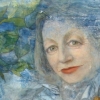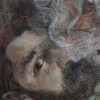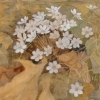Contemporary Romantic
Dorota Kozinska
The idea of an artiste engagé is not new in art, and may in fact be intrinsic to the creative process. From Goya’s macabre evocations of the Horrors of War to Picasso’s Guernica, whose scream reverberates to this day, artists throughout the ages have tangled with this double allegiance; one to their social conscience and the other to the omnipresent spirit of creation. Contemporary artists do not differ from their predecessors, and many find ways of incorporating a social and/or political message, weave it, as it were, into their visual tapestry. In the case of Maja Vodanovic, the process is somewhat reversed, and art in her works is what forges the message into an image, creating a work of art that is at once an homage and an œuvre.
Vodanovic’s paintings do not assault our senses quite in the same way as do those of the above-mentioned masters. They speak in a stroke closer to William Blake’s fluid sweep inspired by the whisper of angelic visions. In these torrid times, Vodanovic chooses to speak in images that “incite” introspection rather than violence, reflection rather than anger. And in all this visual dialogue that her works inspire, there resides a key to a spiritual retreat, an escape into the world of painterly beauty seemingly incongruous with its subject matter.
Born in a country torn from the map by war, Croatian-born Vodanovic has the hot blood of her ancestors, but her fight finds its outlet in beguiling images incongruous with their political subject matter. Vodanovic’s series was born of a long and committed trek into the workings of the bureaucratic machinery of her new home, Canada – and Quebec to be precise- that included encounters with people engaged in the fight for the environment, a topic close to the artist’s heart.
Her research found its voice and outlet in works of art that are at once symbolic portraits of contemporary heroes of her choice, and inspirational paintings that take the viewer beyond the narrative they proclaim. In Vodanovic’s painterly pantheon, Quebec politician André Boisclair, lauded for his battle against pesticides, is transformed into a romantic figure from a fin du siecle medallion, his delicate profile lit by a soft, otherworldly light. Surrounded by symbolic images such as a suspended, Christ-like black bird, he is but a fragment of a larger composition that speaks louder than the message imbedded in it.
The deeply personal portrait of activist Marsha Akman is a symphony of foliage, a page from the lush tapestry of the Pre-Raphaelites, framing the face of the model in a loving embrace. Slightly disheveled, with a bold stare, accompanied by her pet pigeon Peggy, she is a portrait composed of light and shadow and the magical marriage of soothing blues and greens.
Vodanovic uses an alchemic mix of watercolours and liquid acrylic, giving her works a translucent veneer that floats over the texture of the paintings like a warm breeze. The layers that compose the final image are hidden under deceptively sweeping brushstroke, and an unabashed predilection for classicism and aesthetics.
Her homage to Lula, the Brazilian president and former syndicalist, resembles a stained glass mural and is pure secession. The smoke rising from the cigar of the lounging figure mingles invisibly with the eddies where the brushstrokes collide, and the whole tableau is enveloped in a misty greenish haze.
Accompanying the sitter, and visually balancing the composition, is a stylized female figure that appears in many of Vodanovic’s portraits. Like a silent sentinel, she stands in as much for the spirit of the artist, as she does for that of the person she protects with her single wing. A modern Nike, emerging from the psyche of a young painter, she is as ancient as art and as indestructible as the human spirit.
In Vodanovic’s world of contemporary heroes, Quebec’s separatist leader René Lévesque carries the laurel leaf crown of his own, and the winged messenger hovers near his as well. A masterful play of light and shadow marks this portrait, its political message lost in the sunlight and a mesmerising mosaic of butterfly wings.
The history of North American native peoples is profoundly linked with the environment. Billy Two Rivers, a Quebec Mohawk, was chosen by the artist to represent both the struggle and the ancient wisdom of the original settlers of this continent and this work stand out for both its format and impact. Framed into a magnificent triptych, the Mohawk elder is accompanied by a monochromatic depiction of the cascading Lachine rapids, and a romantic portrait of a young native girl, wrapped in virginal white fur. Like three pages from an album, each works speaks volumes, and together they are a painterly trinity to be absorbed on the visceral level, without the aid of accompanying texts.
No words are needed to comprehend the fire burning in the eyes of Zoran Prkut, one of the artist’s uncles. His fate was to stand up to the degrading communist system, and to call on others to follow suit. His presence in the artist’s intimate lineup is there for another reason. “Because Zoran, he’s my uncle.”
It aches a critic to call Maja Vodanovic a political artist, so painterly are her works. It is hard not to salute her dedication and commitment to the common cause, yet what cries out first and foremost is her marvelous handling of the medium – particularly in the service of such a complex issue – and her steadfast adherence to the traditional demands of her craft, without ever forsaking her unique inner vision.













